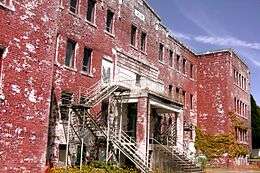St. Michael’s Indian Residential School (Alert Bay)
| St. Michael's Residential School | |
|---|---|
 St. Michael's Residential School in 2003 | |
| Location | |
|
Alert Bay Canada | |
| Coordinates | 50°35′38″N 126°56′30″W / 50.593927°N 126.941770°WCoordinates: 50°35′38″N 126°56′30″W / 50.593927°N 126.941770°W |
| Information | |
| Type | Canadian Indian Residential School |
| Opened | 1929 |
| Closed | 1975 |
| Communities served | Campbell River, Alert Bay, Bella Bella, Bella Coola, Prince Rupert, Haida Gwaii |
St. Michael’s Indian Residential School (1929-1975) in Alert Bay, British Columbia, and sometimes referred to as Alert Bay Residential School, was a Canadian residential school operated by the Anglican Church of Canada for First Nations children in the 20th Century.
History
The first residential school in Alert Bay was built in 1882. St. Michael's was constructed in 1929 as a regional facility to serve aboriginal communities from Campbell River to Prince Rupert, British Columbia and closed in 1975. It was built at a cost of about $250,000 by the federal Department of Indian Affairs next to the U’Mista Cultural Centre which housed the potlatch collection seized by the federal government in 1921 from the Kwakwaka’wakw people.[1]
With space for 200 live-in students, it was the largest operated by the Anglican Church at that time.[2] At the school, First Nations students were prohibited from speaking their language and kept away from their families for years.
Aboriginal children from Northern Vancouver Island and the province's north coast, including from Bella Bella, Bella Coola, the Nisga’a territories and Haida Gwaii were educated at the four-storey red-brick building in the remote community of Alert Bay.[3]
In 1934, the Indian Residential School Commission of the Missionary Society of the Church of England. published that it thanked “Almighty God for what has been accomplished: for a race of people brought in the shortest period of time known in history from the most debasing savagery to citizenship both in the Kingdom of our God and in his God-blessed Dominion of Canada.”[1]
After its closure in 1975, the 'Namgis First Nation was given control of the building and used it for a number of purposes, including housing its own school, a restaurant, a nightclub and band offices. An attempt to raise $15 million in 2001 to house a language centre was unsuccessful. Carvers began using the space but heating and maintenance costs resulted in the band's closure of the building in 2012.[4]
In the early 21st Century, Canada's Indian Residential Schools Truth and Reconciliation Commission judged claims about physical and sexual abuse in the former school and awarded compensation to complainants.
In February 2015, church leaders, First Nations (including representatives of Assembly of First Nations), politicians and former students attended a healing/cleansing ceremony hosted by the 'Namgis First Nation to mark the demolition of the closed school's building.
See also
References
- 1 2 Griffin, Kevin (June 7, 2008). "St. Michael's Residential School at Alert Bay". Vancouver Sun. Retrieved 15 February 2015.
- ↑ Rardon, J.R. (Feb 12, 2015). "Residential school demolition to help close door on dark period". Campbell River Mirror.
- ↑ Meissner, Dirk (Feb 15, 2015). "Demolition ceremony set for 'haunting' Vancouver Island residential school". Vancouver Sun. Canadian Press.
- ↑ Hyslop, Katie. "Marking the end of a 'Dark Era'". TheTyee.ca.